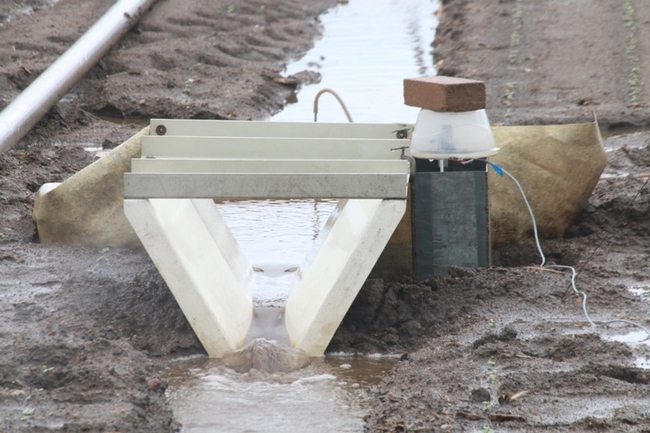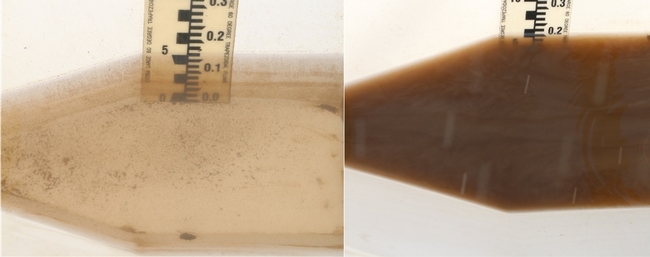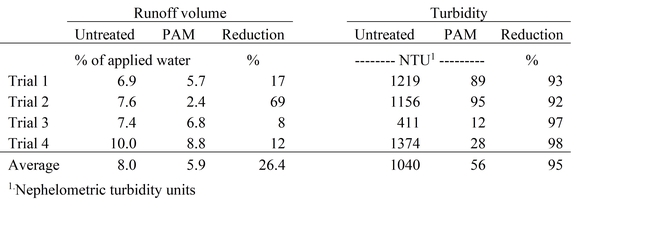As the drought continues on the central coast, growers are trying to utilize water as efficiently as possible to produce their crops. Retaining and reusing sprinkler runoff, also referred to as tail water, can be an important strategy to increasing water conservation. Also, retaining runoff prevents suspended sediments, pesticides and nutrients from impairing rivers and estuaries downstream of agricultural fields.
Many ranches in the Salinas Valley have retention basins and infrastructure that can capture runoff and reuse tail water for irrigating crops. Most growers use this water during the pre-germination or the germination stages to avoid food safety risks from microbial pathogens. However, updates to the leafy green marketing agreement (LGMA) now require that water stored in open reservoirs and used for irrigating leafy greens maintain generic E. coli levels less than 10 MPN/100 ml. In most cases, tail water in open reservoirs will need to be treated with chlorine to achieve this low threshold for generic E. coli. Fine sediments suspended in the tail water can greatly reduce the effectiveness of chlorine to control bacterial growth.
Polyacrylamide (PAM), an inexpensive polymer molecule that has been used for controlling soil erosion in furrow irrigated fields since the early 1990s may be able to improve the efficacy of chlorine by reducing the suspended sediment concentration in sprinkler runoff. Additionally, if runoff is discharged from a ranch, treatment with PAM can greatly reduce the concentration of sediment-bound pesticides and nutrients that can degrade water quality downstream. Past field trials that we conducted have shown that adding PAM to irrigation water at a low concentration (< 5 ppm) is an effective way to minimize erosion in sprinkler irrigated fields and remove suspended sediments from tail water. However, for this strategy to be successful with sprinklers, we found that PAM must be injected continuously throughout each irrigation. In other words, a single application of PAM cannot control suspended sediments in runoff during subsequent irrigations.
New approaches to using PAM
Accurately injecting PAM into a pressurized irrigation system is not a simple process. Dry PAM powder becomes very gooey and viscous when moistened, and is almost impossible to uniformly dissolve into water. Emulsified oil formulations of PAM that mix up uniformly in water are available but are more costly than dry PAM products and require sophisticated pumps to meter it into a pressurized irrigation system, as well as trained staff to assure that the application rate is accurate. Another limitation of liquid PAM is that the mineral oil used to emulsify these products can be toxic to aquatic organisms. In contrast, dry PAM is less than half the cost of liquid PAM and has been shown to have no toxicity to aquatic test organisms such as Hyalella azteca and Ceriodaphnia dubia, even at concentrations 20 times greater than would be typically used for treating irrigation water. Hence, for these reasons, we have been developing and evaluating approaches of using dry PAM to control sediment in sprinkler runoff during the last several years.
Treating pressurized irrigation water with PAM
The first method that we describe in this article uses an applicator to dissolve dry PAM into pressurized irrigation water. The applicator consists of cartridges filled with PAM granules that insert into a series of cylindrical chambers (Fig. 1). A small pump can be used to divert a portion of the irrigation water from the mainline into the inlet of the applicator. PAM slowly releases from the cartridges (Fig. 2) as irrigation water streams through the space between the cartridges and the outer walls of the chambers. Vanes surrounding the cartridges increase turbulence of the flowing water to maximize the dissolution of PAM. The treated water then returns into the main line of the irrigation system where it distributes into the field through the sprinkler system.
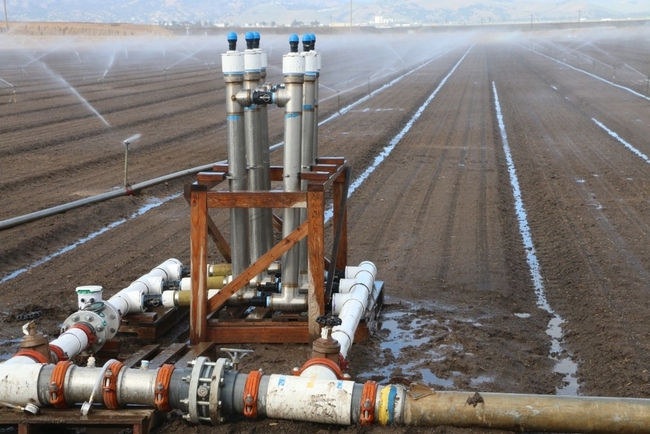
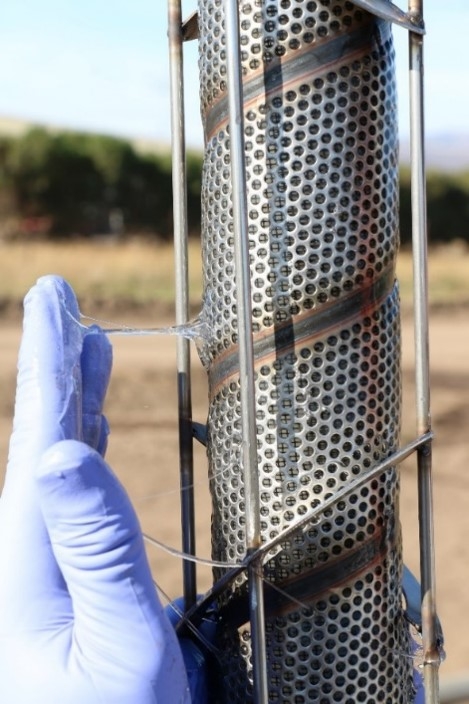
Field-testing the dry PAM applicator
Field-testing of the prototype PAM applicator was conducted in commercial lettuce fields during 2020 and 2021. Each field test occurred during the germination phase of the crop (5 to 6 consecutive irrigations) using overhead sprinklers. The fields were divided into untreated, and PAM treated areas, where the PAM treated plots ranged from 1.9 to 4.2 acres. Soil textures at the sites varied from loam to sandy loam. A portion of the flow in the main lines was diverted through the PAM applicator. Flowmeters were used to measure the flow rate in the mainline and the inlet of the applicator. Another flowmeter monitored the volume of water applied in an adjacent untreated plot.
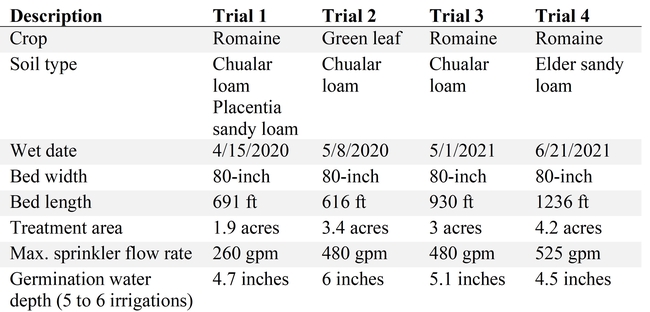
Flumes were installed 30 ft from the far end of the fields to measure run-off volume in the PAM treated and the untreated plots during the irrigations (Fig. 3). A stilling well and float mechanism were used to measure the height of the water in the flume. A datalogger recorded the height of the water in the flume and converted it to a flowrate using a calibration curve. The datalogger also automated sampling of run-off into collection containers using a peristaltic pump. Composite samples of run-off were collected from the plots during 5 to 6 irrigation events and analyzed for turbidity, pH, electrical conductivity, suspended sediments, total nitrogen (N), nitrate-N, total phosphate (P) and orthophosphate at the UC Davis analytical laboratory.
Results of field tests
The average concentration of suspended sediments in the untreated sprinkler runoff ranged from 466 to 1256 milligrams per liter (mg/L) during each trial (Table 2). Results of these field trials demonstrated that pretreating the irrigation water with the PAM applicator could reduce the concentration of suspended sediments carried in sprinkler runoff by 85% to 95%, depending on the soil type. The average reduction in suspended sediment concentration in the runoff was 90% across all trials. Turbidity of the runoff in the PAM treated plots was also reduced by an average of 95% across all sites (Fig. 4, Table 3). Runoff volume in the PAM treatment was reduced by an average of 26%, but the reduction in runoff volume varied from 8% to 67% depending on the site characteristics (Table 3).
Total and soluble phosphorus were reduced by an average of 65% and 14% respectively in the PAM plots compared to the untreated controls in the two trials conducted in 2021 (data not presented). Total nitrogen and nitrate nitrogen concentration in runoff from the PAM treated plots were not reduced compared to the untreated plots.
The combined effects of reduced runoff volume and suspended sediment concentration under the PAM treatment resulted in less loss of soil from these fields (Table 2). Soil erosion was reduced by an average of 93% compared to the untreated control, varying from 89% to 96% reduction in erosion among field sites. Cumulative losses of sediment during the germination phases of the crop were reduced from an average of 76 lbs per acre in the untreated plots to 5 lbs per acre in the PAM treated plots. The sediment lost in the untreated plots would equate to 15 tons for a 200-acre ranch that was planted with 2 crops of vegetables per season. This estimate is only for the germination phase of the crop and so total losses of sediment could be much higher for crops irrigated with sprinklers until harvest.
Potential soil health benefits
Improving soil structure and increasing soil organic matter may be an additional benefit of applying PAM to the field through the irrigation water and preventing the erosion of fine sediments. Much of the stable organic matter in soil is associated with the clay size particles, so preventing the erosion of these fine sediments would presumably help with retaining and building soil organic matter. Fine sediments and organic matter are also important in the development of better soil structure which can improve crop growth.
Summary
The dry PAM applicator that we field tested showed promise for greatly reducing soil erosion, as well as helping improve water quality. Presumably, by removing the sediment from the tail water, less chlorine would be required for controlling microbial pathogens. The six-unit PAM applicator tested in this study can treat up to 500 gpm. The applicator would need more mixing units to treat all the flow from a typical agricultural well in the Salinas Valley (flow rates of 1000 to 1500 gpm). To see a video showing runoff from PAM treated and untreated field plots during a sprinkler irrigation, follow this link. The second part of this article will discuss an additional method to use dry PAM to treat irrigation runoff. This second approach uses an applicator that directly treats runoff in drainage ditches.
Acknowledgments: We greatly appreciate assistance in fabricating the prototype PAM applicators from RayFab. This project was funded by the California Leafy Green Research Board.
